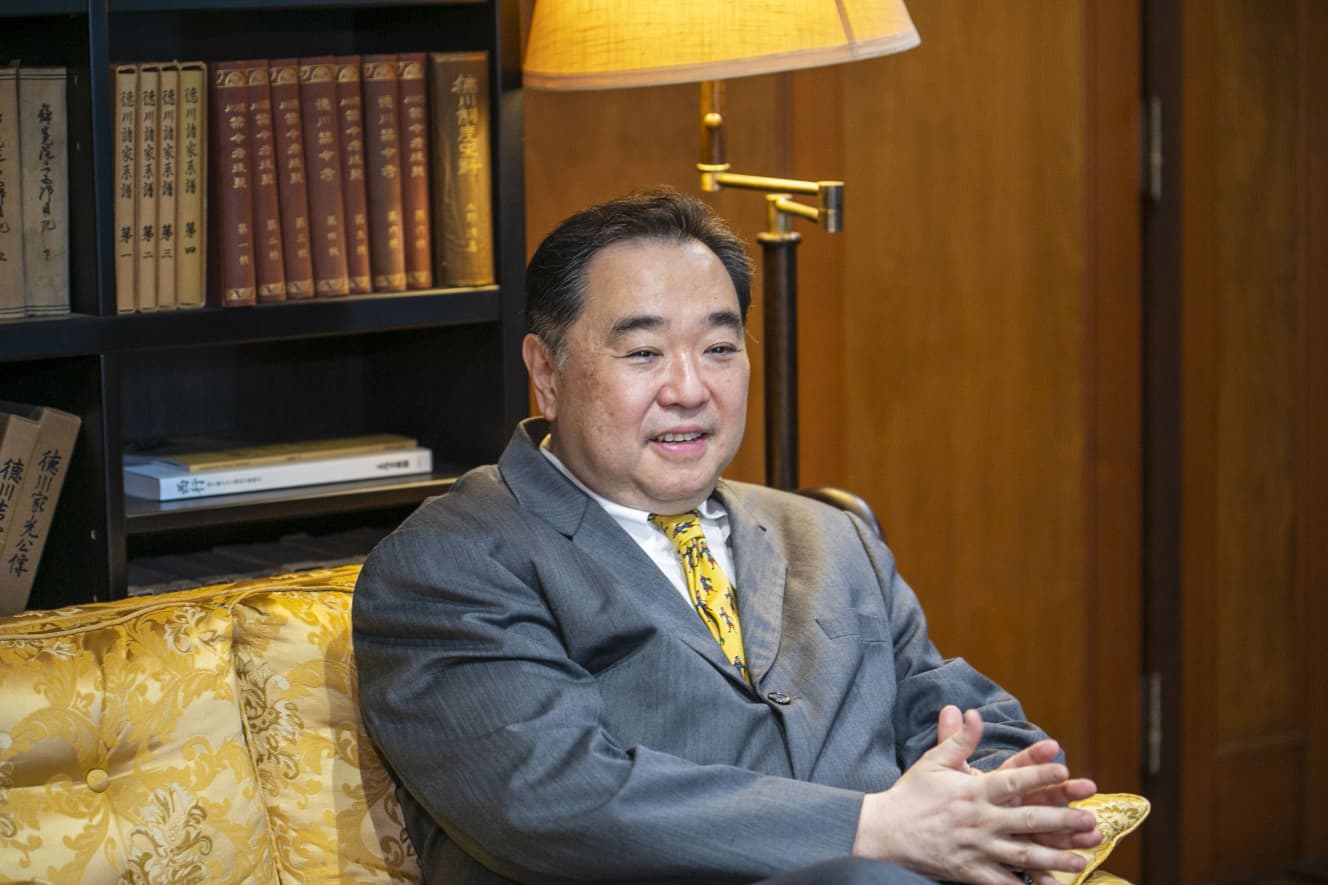How did the grandchildren of the Tokugawa family view the unique historical drama “What to do, Ieyasu”?
The story that overturns the legend that he was “clever and a big man since he was a child…” is a story that overturns such legends…
The NHK historical drama “Dousuru Ieyasu” starring Jun Matsumoto has been called a “fantasy drama,” a “BL drama,” a “tonchiki drama,” and many other things.
From the first episode, Nobunaga Oda played by Junichi Okada tells Takechiyo (Ieyasu/Jun Matsumoto), “Wait for me, Takechiyo. …… my white rabbit,” and in the 15th episode (broadcast on April 23), while pressing Ieyasu to go into battle again, he says, “Think hard. He bit Ieyasu’s ear while whispering in his ear, “We must end this turbulent era.” After the battle of Anegawa, he again bit Ieyasu’s ear saying, “From now on, don’t make a mistake in judgment, White Rabbit,” when Ieyasu was late in starting the battle.
In addition, there was the fact that the recapture of Sena (Kasumi Arimura) had turned into an almost invented ninja fantasy, except for the historical fact that the two sons of Udono Nagateru were exchanged for Sena and her two children as hostages.
Furthermore, the bold allocation of the drama, with only a few historical facts involved and a full episode’s worth of space for the drama’s original characters, has also become a topic of discussion.
By the way, how do Ieyasu’s relatives (descendants) feel about this unique story?
We asked Iehiro Tokugawa, the 19th head of the Tokugawa family, who took over the reigns of the Tokugawa family on January 1 of this year, about his frank thoughts.

I feel that I have finally come to the place where I should be, where I should be “knowledgeable” rather than “compassionate.
I was honestly happy when I heard the title of the film, which was announced about two years ago.
There is a legend about Ieyasu that he was clever and a big shot even as a child. The most famous story is that he pissed standing up in the garden when he first visited Lord Yoshimoto Imagawa. So people around him were fascinated by him. But I always thought that such a thing was impossible.
As you may recall from the current Russian invasion of Ukraine, the Mikawa province and the Matsudaira family in Ieyasu’s time was a weak country and family, with surrounding major powers reaching out to them rapidly. So, Ieyasu’s life was a struggle. Therefore, Ieyasu’s life must have been a series of difficult choices, and if we could portray this honestly, the audience would be able to easily become emotionally involved with Ieyasu.
Moreover, Ryota Furusawa, who wrote the screenplay, is a writer of puzzle-like entertainment, so I thought the story would appeal to the “intellect” rather than the “emotions. The Warring States period was a time when even those with nothing could reach the top by making full use of their wits.
Ieyasu has always been associated with the image of a cunning “raccoon father,” but one past historical drama that overturned this image was “Sanadamaru” (’16), scripted by Koki Mitani. In fact, Iehiro’s favorite character is Ieyasu, played by Masaaki Uchino in “Sanadamaru. He was portrayed as a timid, cautious, small-minded, and pathetic man, especially when he was young. ……
I thought Ieyasu in “Sanadamaru” would be rather correct. In the Warring States period, when the future was uncertain, it was true that people with bad personalities were more likely to survive.
However, there were quite a few Ieyasu fans who were dissatisfied with the way he was portrayed.
The image of Ieyasu as weak-minded, quick to flee, quick to snap, quick to have a stomach ache…
In this sense, the image of Ieyasu in “What to Do About Ieyasu” is similar to the way he is portrayed in “Sanadamaru. I wonder how Ieyasu, who is weak, quick to flee, quick to snap, and quick to get hungry, is portrayed in “Sanadamaru.
I don’t know if he really was like that, but there is enough breadth in his image to make us think that he might have been like that.
Recently, it is said that Ieyasu had acquired Buddhist values and read Chinese classics, but I think Chinese history books were more like how-to books in those days. I think it was possible that Ieyasu may have applied or imitated them as they were.
This seemed like an amazing thing to the uneducated Mikawa people, but it was surprisingly common in the Imagawa family. It is clearly depicted that there was a big cultural gap between those who received higher education at the Imagawa family and those who came to the poor Mikawa region.
Moreover, the fact that Ieyasu was weak-minded does not mean that he was like that, but rather that the situation in Mikawa, which was in a constant state of crisis with Takeda reaching out from the north, Imagawa from the east, and Oda from the west, was all made into a personal problem for the main character. Ieyasu Ieyasu symbolizes the Matsudaira family and the country of Mikawa. When he is in a situation like this, as a flesh-and-blood human being, he really gets a stomach ache (laughs).

Ease of Understanding and Entertainment
He also noted that the two main points of interest are “ease of understanding” and “entertainment.
What I think NHK has thought about very carefully is that there is a large generation gap among Japanese people, and there are a certain number of people who know nothing about Japanese history.
I myself went to New York in the U.S. from the first to fourth grade of elementary school. I myself am a returnee from Japan, having lived in New York City from the first to fourth grade of elementary school, so when I was in elementary and junior high school, I had a very hard time with Japanese history classes that had a lot of kanji characters. However, up to my generation, there were still many people who were born before World War II, and through reading novels and talking to people around me, knowledge of Japanese history existed as if it was common knowledge.
However, there are probably people in their 20s and 30s who know nothing about Japanese history, and many of them may have only learned about it through video games. Since the game was created in line with the reality of Japan, I thought that “What to do with Ieyasu” would be popular even if it were distributed in Latin America, Africa, or the Middle East, for example, where people know nothing about Japanese history.
The scene where Sena and Ieyasu are playing “make-believe”…
On the other hand, there are many descriptions and settings that seem to cause discomfort and confusion. One such example is the relationship between Nobunaga and Ieyasu.
When it was first announced, there were reports of ‘friendship between Nobunaga and Ieyasu. When I heard that, I thought, ‘There is no such thing.
I think Lord Ieyasu hated Nobunaga. I was worried that they were going to make it into a ‘friendship’ story. Then again, there is absolutely no way that Lord Ieyasu would go and find out about the revolt on his own, but it is certainly interesting as a drama.”
He was also “surprised” by the scene in the first episode in which Sena, played by Kasumi Arimura, and Ieyasu are playing make-believe.
He also said he was “surprised” by the scene in the first episode in which Ieyasu and Sena, played by Kasumi Arimura, play make-believe.
The two of them don’t look like children, so their portrayal was a little creepy.

What are your concerns and expectations for the future development of the film?
We also asked the participants about their concerns and expectations for the future development of the series.
What I am most concerned about is how much of the process from Toyotomi Hideyoshi’s (Murotsuyoshi) invasion of Korea to his unification of Japan will be depicted.
I have a theory that it would be strange to have a sympathetic view of Toyotomi after Ieyasu destroyed the Toyotomi family, since this man (Hideyoshi) clearly took over the Oda family. I would like to see Hideyoshi portrayed as a monster (as he really was).
In particular, I hope that the absurdity of the Joseon invasion and his unpopularity among the feudal lords will be portrayed properly. At the end of Hideyoshi’s line of unifying the country, there was the Joseon expedition, and after it ended in a fiasco, a man named Tokugawa Ieyasu emerged. Toyotomi Hideyoshi is so important in depicting Ieyasu that no matter how carefully I talk about him, it is not enough.”
Tokugawa Iehiro ’23 has been the 19th head of the Tokugawa Soke family since January 2011, and held a commemorative ceremony, the “Succession Ceremony,” at Zojoji Temple on January 29, 2011. After graduating from Keio University, he earned a master’s degree in economics from the University of Michigan. He worked for the Foundation for Advanced Studies on International Development (FASID), the Food and Agriculture Organization of the United Nations (FAO) at its headquarters in Rome and its branch in Vietnam (Hanoi), and then completed his graduate studies at Columbia University’s Graduate School of Political Science, where he received a Master of Arts in Political Science (International Relations). He is currently active as a political commentator, translator, and author, including subtitle translation for the film “The Green Zone. He is President of the Tokugawa Memorial Foundation and Visiting Professor at Nagasaki University’s Center for International Collaborative Research and Strategy. He is also a member of the board of directors of the Kunouzan Toshogu Museum and the Nikkozan Rinnoji Treasure Hall, which have permanent exhibits of items related to the Tokugawa family.

Interview and text by: Wakako Takou
Born in 1973. After working for a publishing company and an advertising production company, became a freelance writer. In addition to interviewing actors for weekly and monthly magazines, she writes columns on drama for a variety of media. His main publications include "All the Important Things Are Taught by Morning Drama" (Ota Publishing), "KinKi Kids Owarinaki Michi" and "Hey! Say! JUMP 9 no Tobira ga Open Tokimono" (both published by Earl's Publishing).
PHOTO: Mayumi Abe